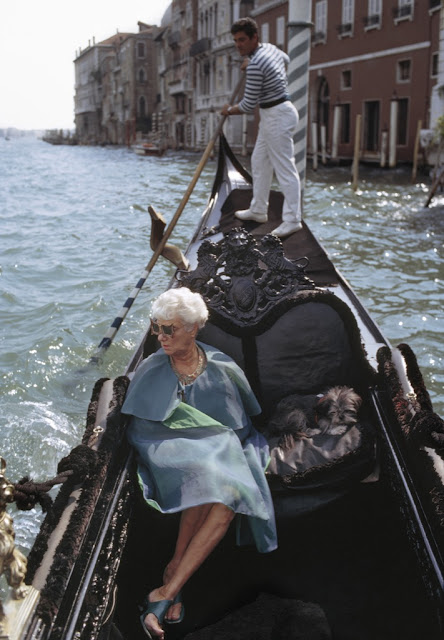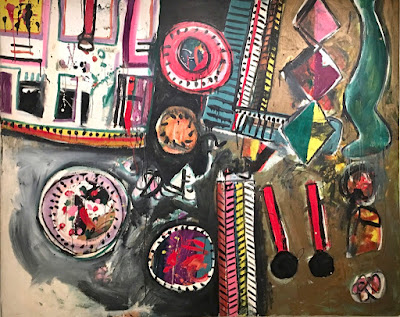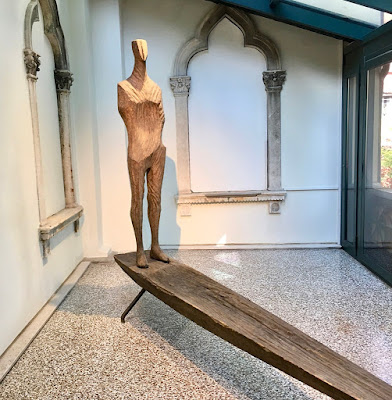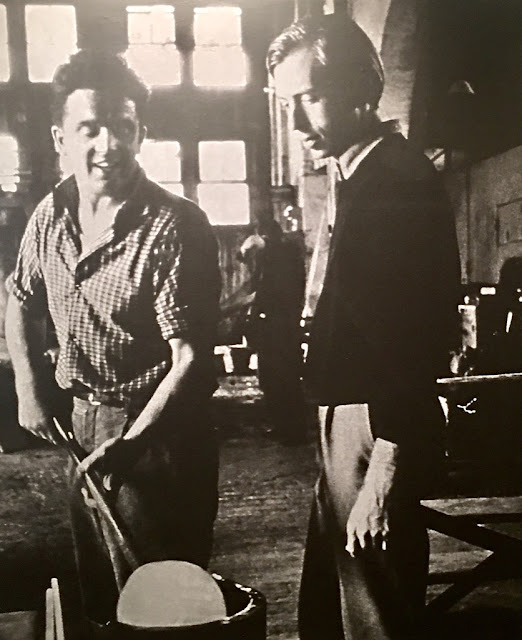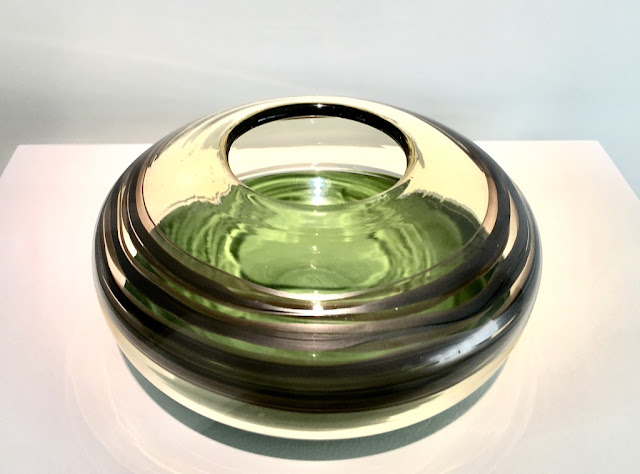Photo Tony Vaccaro / Tony Vaccaro
Archives
“It is always assumed that Venice is the ideal place for a honeymoon. This is a grave error. To live in Venice or even to visit it means that you fall in love with the city itself. There is nothing left over in your heart for anyone else.”
Peggy Guggenheim,
Out of This Century - Confessions of an Art Addict
Peggy Guggenheim Collection
The Last Dogaressa
The exhibition The Last Dogaressa, until January 27, is curated by Karole
P. B. Vail with Grazina Subelyte, it celebrates
Peggy Guggenheim’s Venetian life, shedding light on how
she significantly continued to add works of art to her collection after her
departure from New York, having
closed her museum-gallery Art of This
Century - 1942–47 - and having made
Venice her home in 1948.
Peggy
Guggenheim - Venice
– 1968
The exhibition presents a selection of
paintings, sculptures and works of paper that Guggenheim acquired from the late 1940s to 1979, the year in which
she passed away, while simultaneously highlighting the milestone events and
exhibitions that she organized and participated in. Focusing on the last three
decades of Guggenheim’s acquisitions, the exhibition offers an unparalleled
opportunity to revisit and re-contextualize renowned masterpieces. These
comprise Rene Magritte’s Empire
of Light, alongside
rarely exhibited works by artists such as Rene
Bro, Gwyther Irwin and Grace Hartigan, as well as the Japanese-born Kenzo Okada and Tomonori
Toyofuku, thus conveying Guggenheim’s interest in art beyond Europe and the United States.
Jackson
Pollock – Two –
1943-45
Peggy Guggenheim Collection
The Last Dogaressa
A selection of Guggenheim’s scrapbooks are on display to the public for the first
time. These are fascinating albums in which she meticulously collected
newspaper articles, photographs, and ephemera covering the various periods of
her life revealing new exciting episodes.
Peggy
Guggenheim Scrapbook
– 1948-49
In 1948, Guggenheim
was invited to exhibit her collection at the 24th Venice Biennale:
it was the first presentation of her collection in Europe after the
closure of her New York gallery, Art of This Century. The exhibition opens with a tribute to this
seminal event: the works of art exhibited in the Greek pavilion were at
the time the most contemporary exhibited at the Biennale, most notably those by
the young American Abstract Expressionists, which created a sensation.
In addition, the exhibition marked Jackson Pollock’s debut in Europe
and the first presentation of a new generation of artists who, in the following
years, would dominate the international art scene. The same works by Arshile
Gorky, Robert Motherwell, Mark Rothko, and Clyfford Still exhibited
in 1948 open this show. Important works by Pollock are on view, including Alchemy
and Enchanted Forest, thus paying tribute to his first solo
exhibition in Europe, which was organized by Guggenheim in 1950 in the Ala
Napoleonica in Piazza San Marco, Venice
Jackson
Pollock – Alchemy
- 1947
This is perhaps the first painting Pollock made with the revolutionary
technique of pouring and dripping paint on the canvas placed on the floor.
Curators Grazina
Subelyte and Karole P. B. Vail
David
Hare - Moon Cage - Windows of Moons – 1951 ca.
With a reference to the
first show Guggenheim organized at Palazzo Venier dei Leoni in 1949,
marking this year its 70th anniversary:
an exhibition of contemporary sculpture, with works such as Jean Arp’s
Head and Shell the founding work of the collection, Constantin Brancusi’s
Bird in Space and Alberto Giacometti’s Piazza.
Jean Arp –
Head and Shell
– Tete et Coquille – 1933 ca.
Photograph courtesy
Peggy Guggenheim Collection – copyright Grace Hartigan estate –
collezione Peggy
Guggenheim - Venezia
“I want
an art that is not ‘abstract’ and not ‘realistic’ – I cannot describe the look
of this art, but I think I know it when I see it.
Grace
Hartignan
Grace
Hartigan – Ireland
– 1958
Oil on canvas - 200x271
cm
The Italians
After her arrival in Venice in 1947, Peggy
Guggenheim commenced a new phase of collecting as she began supporting and
acquiring works by local Italian artists.
Her first acquaintances were the Venetian
painters Giuseppe Santomaso and Emilio Vedova. In the post–World War II period, Vedova became one
of the principal Italian proponents of Art
Informel abstraction. Politically engaged, during the war he took part in
the Italian resistance movement, often using his art to express his views. Image
of Time – Barrier – 1951 - was born out of his investment in
moral and social issues. Guggenheim saw in Vedova a rising star of the European avant-garde and acquired the
painting when the artist was in his late thirties.
Emilio
Vedova – Image of Time – Barrier – 1951
Photograph courtesy
Peggy Guggenheim Collection – copyright Piero Dorazio Siae 2019 –
collezione Peggy
Guggenheim – Venezia
Piero
Dorazio – Unitas
– 1965
oil on canvas 45,8 x
76,5cm
In 1951, the American artist William
Congdon introduced Guggenheim to
Tancredi Parmeggiani, a painter from
Feltre. She quickly championed the Italian artist, giving him a monthly
stipend and a studio space in the basement of her palazzo, and promoting and
organizing exhibitions of his work, including a solo show in her home in 1954.
Tancredi was a member of the Spazialismo
movement, founded by Lucio Fontana
in the 1940s, and developed his personal poetics of infinite space through the
exploration of the relationships between the painted mark, color, and light, as
in Composition.
Tancredi
Parmeggiani – Composition – 1957
“I find
myself in nature and nature in myself.”
Kenzo
Okada
In Above the White, shapes and
colors float across the surface of the canvas, evoking what was traditionally
called a “landscape of the mind.”
Although
the composition is markedly abstract, it was likely inspired by nature, as
Okada noted.
Kenzo
Okada – Above the White – 1960
British
Art
In the 1950s, Peggy Guggenheim focused
on collecting British art. She purchased sculptures by Kenneth
Armitage, Reg Butler, and Lynn Chadwick, who had great success when
they were introduced to the international art world at the 1952 Venice
Biennale, as part of a new generation of young British artists. On this
occasion, a sculpture by Henry Moore, whose work Guggenheim also
collected, was installed at the entrance of the British pavilion,
positioning him as the forefather of his younger peers. These sculptors united
in their engagement with the figure, whether human or animal, and several
abandoned the traditional bronze-casting method in favor of forging and
welding.
Henry
Moore
Family
Group –
1944 ca. – Reclining Figure – 1938
Stringed Object
– Head
– 1938
Through the 1960s, Guggenheim added paintings to her holdings, such as Study
for Chimpanzee by the Irish-born
artist Francis Bacon, February
1956 – menhir - by Ben Nicholson, and Organic
Form by Graham Sutherland,
among others. Bacon’s and Sutherland’s compositions depict figures set against
plain-colored grounds: a chimpanzee and an organic form reminiscent of an altar
respectively.
Graham
Sutherland – Organic Form – 1962-68
Op and Kinetic Art
The exhibition also
includes highlights of works of Op and Kinetic art, which piqued Guggenheim’s
interest in the 1960s, by Marina Apollonio, Alberto Biasi, Martha
Boto, Franco Costalonga, Heinz Mack, Manfredo Massironi, and Victor
Vasarely. Op artists made use of geometric forms and structures, industrial
materials to create optical effects and perceptive illusions; they also
exploited the transparent and reflective properties of materials such as
aluminium, plastic, and glass. Their objects had a deliberate de-personalized look, in contrast to the emotional visual
idiom of Abstract Expressionism.
Marina Apollonio – Relief N. 505 – 1968 ca.
Heinz Mack – The Joy of Calvin – 1963
“When I was walking through the Campo Manin, I noticed a very exciting
painting in the window of a little art gallery. My first reaction was to take
it for a Pollock. I went in and met the artist … Though his work was not bought
by anyone except me for years, he is one of the best British painters.”
Peggy Guggenheim
Peggy Guggenheim’s interest in British art led her to
acquire works by British artists Gwyther Irwin and by Scottish painter Alan Davie,
in particular, she admired and encouraged Davie’s talent from the time that she
discovered his work at his exhibition at the Galleria Sandri in Venice
in 1948.
Exhibition View
Alan Davie – The Golden Drummer Boy No. 2 - 1962
In the 1960s, Guggenheim purchased Shelter by the
Austrian painter Friedensreich Hundertwasser, and Autumn
at Courgeron by the French painter Rene Bro. The two artists
shared a studio in a country manor that Bro had restored in Courgeron, a
small town in Normandy, France. This is where he likely made Autumn at
Courgeron, a landscape populated by trees, painted in his typically simple,
child-like style. For Hundertwasser, Bro’s landscapes were otherworldly, and
his “round, radiant trees [had] souls and an inner life.”
Rene Bro – Autumn at Courgeron – 1960
Boite-en-Valise
Simultaneously on display at Palazzo
Venier dei Leoni are works Guggenheim purchased between
1938, when she opened her first gallery in London, Guggenheim Jeune, and
1947, when she moved to Venice. The opportunity to see her collection
almost in its entirety, including masterpieces such as the first Box in a
Valise - Boite-en-Valise - created by Marcel Duchamp especially for
Guggenheim in 1941, is not to be missed. The work contains one ‘original’ and sixty-nine
miniature reproductions of famous works by the multifaceted and irreverent French-American
artist. It is rarely on view to the public due to its fragility, and it is now
possible to admire it as it has returned to Venice after an important study and
conservation campaign.
Marcel Duchamp - Box in a Valise - Boite-en-Valise – 1941
Marcel Duchamp - Box in a Valise - Boite-en-Valise – 1941
Vivien Greene and Francesca Lavazza
Dr. Vivien M. Greene
is co-author with Karole P. B. Vail of the book, The Last
Dogaressa, and Francesca Lavazza is Corporate Image Manager of Lavazza coffee, who is one of the institutional
patrons of the Peggy Guggenheim Collection.
Tomonori Toyofuku – Drifting No. 2 - 1959
